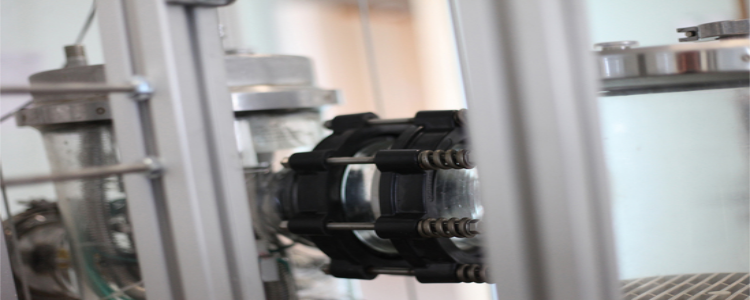Sorption systems are one of the laboratory's strong points, whether for thermal energy conversion (heat or cold production) or energy storage. LOCIE has developed a range of experimental rigs to meet its needs, enabling it to study transfer phenomena and characterize components and systems. Developed to provide generic experimental tools for the study of absorption machines, they are currently being redesigned with a view to reducing their number and increasing their versatility.
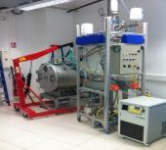 The "Absorption" bench developed as part of an industrial project is dedicated to the study of absorbers for LiBr/H2O sorption systems. The main chamber, 1 m in diameter, can accommodate individual plates or components up to 50 cm square. Operating pressure is set by a plate evaporator and trickling film. The concentration of the solution is adjusted to the desired value by a flooded desorber coupled to a condenser. The power of the absorbers that can be studied is limited to 3 kW. The side doors are fitted with viewing windows, which can be fitted with calcium fluoride windows for infra-red thermography.
The "Absorption" bench developed as part of an industrial project is dedicated to the study of absorbers for LiBr/H2O sorption systems. The main chamber, 1 m in diameter, can accommodate individual plates or components up to 50 cm square. Operating pressure is set by a plate evaporator and trickling film. The concentration of the solution is adjusted to the desired value by a flooded desorber coupled to a condenser. The power of the absorbers that can be studied is limited to 3 kW. The side doors are fitted with viewing windows, which can be fitted with calcium fluoride windows for infra-red thermography.
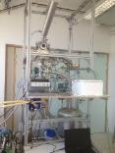
The "desorber/condenser" bench developed as part of an industrial project with PSA is dedicated to the study of highly compact industrial desorber and condenser exchangers for the automotive industry. It will soon be equipped with a confined-space desorption characterization cell, with a view to carrying out academic studies as part of the ANR FRAISE program. Component power is limited to 6 kW.
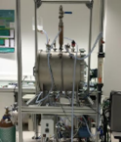 The "evaporation" bench developed as part of the ANR ECOSS project is dedicated to the study of plate evaporators/condensers and trickling films operating with water as the cooling fluid at low temperatures (7°C) and low pressures (10 mb). The 0.7 m-diameter main chamber can accommodate single plates or components up to 40 cm square. The power of the evaporators/condensers that can be studied is limited to 2 kW. The side doors are equipped with viewing windows, which can be fitted with calcium fluoride windows for infra-red thermography.
The "evaporation" bench developed as part of the ANR ECOSS project is dedicated to the study of plate evaporators/condensers and trickling films operating with water as the cooling fluid at low temperatures (7°C) and low pressures (10 mb). The 0.7 m-diameter main chamber can accommodate single plates or components up to 40 cm square. The power of the evaporators/condensers that can be studied is limited to 2 kW. The side doors are equipped with viewing windows, which can be fitted with calcium fluoride windows for infra-red thermography.
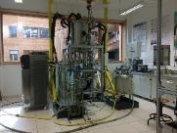
The absorption heat storage bench developed as part of the ANR PROSSIS 2 project is dedicated to the study of low-temperature (up to 100°C), medium-term (monthly) or long-term (inter-seasonal storage) solar energy storage for building heating. Storage of the concentrated solution can be accompanied by crystallization of the solution. Two couples were tested: LiBr/H2Oand KHCOO/H2O

The film hydrodynamics bench is a modular elementary bench dedicated to studying the hydrodynamics of films running off vertical or inclined plates.
These generic test benches are complemented by prototype machines, such as the absorption air-conditioning prototype for automotive applications, or the ammonia-water heat transformer prototype currently under development.
The laboratory uses dry vacuum pumps, a helium leak detector and various thermal units to operate its installations. Solution concentrations are measured using high-precision Coriolis flowmeters. The laboratory uses a Photron FASTCAM x1024 high-speed camera and a STIL CCS Prima confocal microscope to study the hydrodynamics of falling films. The interface temperature of falling films is measured by FLIR SC 7000 infrared thermography.
